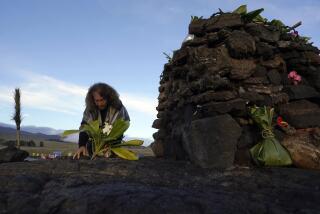Voices of Ancestors Sing Across Time
- Share via
Shortly after dawn on a May morning in 1930, two Australian gold prospectors led an expedition into the highlands of what is today Papua New Guinea and discovered a civilization of 1 million people who had never before had contact with the outside world. It was perhaps the last epic encounter between “advanced” Western society and an ancient culture long sheltered from foreign eyes.
That first moment of contact in New Guinea represented both an end and a beginning, for once a single people meets another, each is changed forever. But out of change can come respect and understanding.
The highlands meeting is instructive to our contemporary world, so often marred by racial tension and conflicts based on religious or cultural antagonism, ignorance or fear. An old man rubbed one of the anthropologist’s white legs to see if it was painted. Some of the older women wept with joy, for they believed the strange figures who had suddenly appeared were ancestral spirits returned from the dead. To the highland women, all people had always been one people.
During my own recent expedition in New Guinea, I met a Catholic priest, Father Danbui, on the remote Sepik River, far from the highlands. The tribes along its banks speak nearly 200 languages, testifying to the remarkable cultural diversity of this nation.
Father Danbui had been born in New Guinea and had been converted to Catholicism. As we sat in a house on stilts overlooking the muddy river, he explained to me that Sepik people sought in their own timeless legends an explanation for how strangers came to be among them. He told the tale of two brothers--the elder married and stable, the younger a bachelor with inventive ways.
One day the younger brother and his brother’s wife were gathering wood at the river. After the work was done, the two went bathing and later the young brother began drawing beautiful designs in the sand. The woman, pleased at the sight and innocent of the consequences, asked him to trace the same lovely images on her back. As he did so, some villagers came upon the two. The younger brother was expelled from the village for his transgression with his brother’s wife.
According to Father Danbui, when German missionaries arrived in the village in the 1870s, the local people were startled by their white skin and blond hair, and by their metal tools that enabled them to build unfamiliar things. Seeking an explanation for who these odd people were, the villagers--ignoring the difference in skin color--decided that, in these missionaries, the exiled brother had returned.
Father Danbui uses this story to illustrate how foreign religions came to be accepted, and practiced, by tribal people. In fact, he himself embraced a foreign religion, but not by abandoning traditional beliefs.
When New Guinea achieved independence in 1975 and became the nation of Papua New Guinea, Father Danbui--at the urging of his people--became the equivalent of province governor.
He steers a path between culture and politics, between social integration and tribal autonomy. Above all, he seeks to combine outside ways with ancient tradition, because he is proud of his birthright. When he conducts Catholic Masses, the music for the Mass is often played by local people on sacred wooden flutes--flutes that have been used in Sepik rituals for countless centuries.
Their rich-toned sounds, however, are more than music. For the celebrants of the Mass, they are the voices of ancestors singing across time, the voices again of one people.
More to Read
Sign up for Essential California
The most important California stories and recommendations in your inbox every morning.
You may occasionally receive promotional content from the Los Angeles Times.











